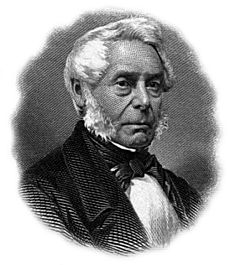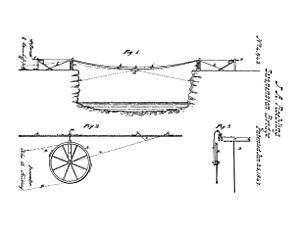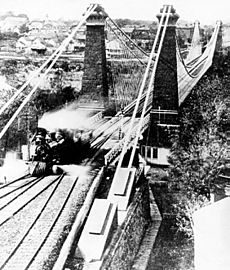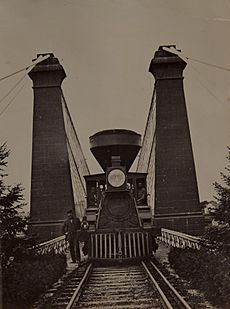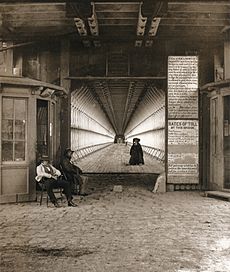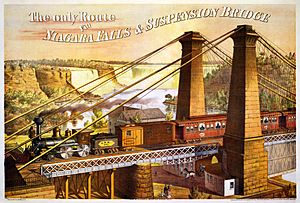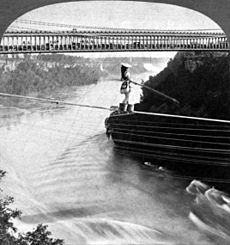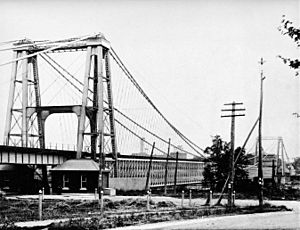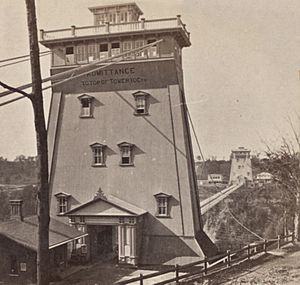Niagara Falls Suspension Bridge facts for kids
The Niagara Falls Suspension Bridge was an amazing bridge that stood from 1855 to 1897. It crossed the Niagara River and was the world's first working suspension bridge for trains!
This bridge was 825 feet (251 m) long. It was located about 2.5 miles (4.0 km) downstream from Niagara Falls. It connected Niagara Falls, Ontario in Canada to Niagara Falls, New York in the United States.
The bridge had two levels. Trains used the top level, while people and horse-drawn carriages used the bottom. Canadian leaders first thought of the idea for the bridge. It was built by companies from both the U.S. and Canada. People often just called it the Suspension Bridge.
This bridge was a very important border crossing between Canada and the United States. It helped connect cities on both sides of the border with three railway lines. The bridge also played a big part in history, like helping people escape to freedom during the Underground Railroad.
The bridge showed that a suspension bridge could be strong enough for trains. Over time, its wooden parts were replaced with stronger steel and iron. But as trains got much heavier, a new bridge was needed. The Suspension Bridge was taken down in 1897 and replaced by the Whirlpool Rapids Bridge.
Quick facts for kids Niagara Falls Suspension Bridge |
|
|---|---|
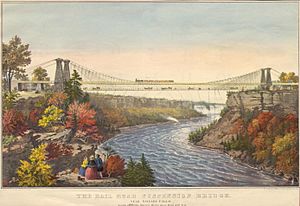
Hand-colored picture of the Suspension Bridge from the American side. You can see the bridge, Niagara Falls far away, and the Maid of the Mist boat below.
|
|
| Coordinates | 43°06′33″N 79°03′30″W / 43.109208°N 79.058336°W |
| Carries | Trains and carriages |
| Crosses | Niagara River |
| Locale | Niagara Falls, New York and Niagara Falls, Ontario |
| Official name | International Suspension Bridge (United States) Niagara Falls Suspension Bridge (Canada) |
| Maintained by | Niagara Falls International Bridge Company (United States) Niagara Falls Suspension Bridge Company (Canada) |
| Characteristics | |
| Design | Suspension bridge |
| Material | Wood, limestone, cast iron, and wrought iron (later replaced with steel) |
| Longest span | 825 feet (251 m) |
| Load limit | 450 short tons (410 t; 400 long tons) |
| Clearance below | 250 ft (76 m) |
| History | |
| Designer | Charles Ellet, Jr. (1847–48) John A. Roebling (1851–55) Leffert L. Buck (1877–86) |
| Opened | August 1, 1848 (temporary bridge) March 18, 1855 (railway) |
| Closed | 1896, taken apart by August 27, 1897, replaced by the Whirlpool Rapids Bridge |
| Statistics | |
| Daily traffic | 45 trains per day (1860) |
| Toll | 25 cents per person, 50 cents per horse-carriage, 50 cents per carriage passenger (1873) |
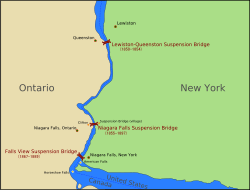
Map of the Niagara River, showing the suspension bridges downstream from the Falls
|
|
Contents
Building the Bridge
In the mid-1800s, people wanted to connect cities in North America with new trade routes. A Canadian leader named William Hamilton Merritt had a big idea. He wanted to build a railway suspension bridge across the Niagara River below the famous falls.
Merritt got the idea for the bridge while picnicking by the Niagara River in 1844. His sons were traveling in Europe and wrote to him about an amazing suspension bridge in Switzerland. This made Merritt wonder if a similar bridge could cross the Niagara.
He worked hard to get permission. In 1846, both New York State and the Canadian government agreed. They allowed companies to be formed to build the bridge.
Before the bridge, people crossed the Niagara River by boat. One famous boat was the Maid of the Mist, which started in 1846. It took tourists close to the falls. The bridge was built about half a mile from where the Maid of the Mist landed. The spot was chosen because it was the narrowest part of the gorge. It was 800 feet (240 m) wide and 230 feet (70 m) deep.
Building a suspension bridge for trains was a huge challenge. Many engineers thought it was impossible. Suspension bridges were known to be shaky. Some had even collapsed before. Engineers worried a train's weight would be too much.
Four engineers offered their plans: Edward Serrell, Samuel Keefer, Charles Ellet, Jr., and John A. Roebling. Ellet and Roebling were already famous for building suspension bridges. Roebling sent detailed plans for a double-deck bridge. But Charles Ellet, Jr. was very active in promoting his ideas. He even offered to buy a lot of stock in the bridge companies. Because of his efforts, he won the contract in November 1847.
Charles Ellet, Jr.'s First Bridge
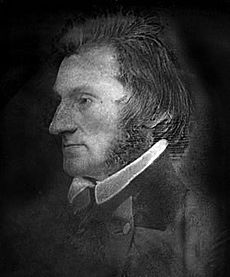
Charles Ellet, Jr. was a talented engineer who studied in France. He was known for being a great speaker and showman. He used these skills to get people excited about his bridge ideas. He won contracts for both the Niagara Suspension Bridge and the later Wheeling Suspension Bridge.
Ellet's first plan for the Niagara bridge had all traffic on one level. Trains would not use their heavy engines on the bridge. Instead, horses or lighter engines would pull the train cars across.
The first big problem was getting a line across the 800 feet (240 m) wide gorge. Ellet thought of many ideas, like firing a cannonball with a line attached. But he chose an idea inspired by Benjamin Franklin's kite experiments.
Ellet held a kite-flying contest in January 1848. He offered $5 to any boy who could fly a kite across the gorge and tie the string on the other side. A 16-year-old boy named Homan Walsh finally succeeded. He launched his kite from the Canadian side.
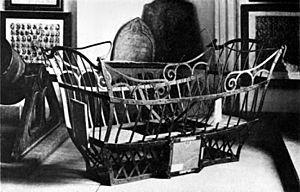
After the kite string was across, Ellet's team pulled heavier and stronger lines over. Finally, a thick cable was hanging across the gorge. This cable was used to create a basket ferry. It would carry workers and materials across the gorge.
On March 13, 1848, the basket system was ready. Ellet stepped into the basket himself to show it was safe. He became the first person to cross the gorge in this way. Even though he wasn't supposed to, Ellet charged people $1 to ride the basket. Many people came to watch and ride.
Ellet then built two footbridges and joined them to make an 8-foot (2.4 m) wide temporary suspension bridge. He planned to use this as a platform to build the permanent railway bridge. On July 29, 1848, Ellet showed off the bridge by riding across it in his horse-buggy. This stunt brought more attention and money.
However, Ellet had disagreements with the bridge companies about money. He even put cannons on the bridge to claim it was his! The issue went to court. Ellet was paid $10,000 and left the project.
The Niagara Suspension Bridge project stopped for three years. Then, the companies hired another famous engineer, John Augustus Roebling, to finish it.
John Augustus Roebling's Railway Bridge
John Augustus Roebling was born in Prussia (now Germany). He studied engineering and later moved to the United States. He started his own company to make wire cables. Roebling became famous for building suspension bridges. His first big bridge was the Allegheny Suspension Aqueduct in Pittsburgh in 1845.
Roebling invented a new way to make the main cables for suspension bridges. Instead of making huge cables in a factory, he spun them right at the bridge site. A special wheel would carry wires across the gap, back and forth. These wires were then grouped together to form thicker strands, and finally, the huge main cables. This method became the standard for building suspension bridges for many years.
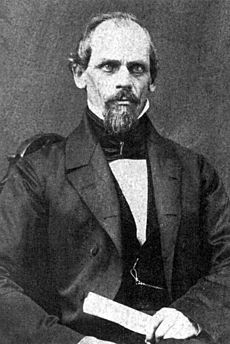
Roebling was very different from Ellet. He was serious and focused on science and exact calculations. He was confident in his work and wasn't afraid to say that his bridges were better than others. He even called European suspension bridges weak! Roebling learned that he needed to promote himself to get big projects.
When Roebling took over the Niagara project in 1851, he had already built six suspension bridges. He thought Ellet's final plan was too heavy and expensive. Roebling used his own double-deck design. The lower deck was for people and carriages. The upper deck, 18 feet (5.5 m) above, was for trains. Trains could cross without stopping, though they had to go slowly, about 5 miles per hour (8.0 km/h).
Roebling believed that the two decks and strong trusses (support structures) would make the bridge very stiff. This would prevent it from swaying too much, which was a big worry for train bridges. Other engineers were doubtful. Robert Stephenson, a famous British engineer, even said if Roebling's bridge worked, his own tubular bridge was a "magnificent blunder."
Despite the doubts, Roebling finished the bridge in four years. He used Ellet's old bridge as a scaffold. On March 8, 1855, a 23-short-ton (21 t) steam engine called London crossed the railway deck to test it. Ten days later, on March 18, 1855, the upper deck officially opened. The lower deck had opened a year earlier. When the first passenger train crossed, Canada and the United States were finally connected by rail across the Niagara River. Roebling's Suspension Bridge became the first successful railway suspension bridge in history.
How the Bridge Worked
Roebling's bridge was held up by two strong limestone towers on each side of the gorge. These towers were 88 feet (27 m) tall on the American side and 78 feet (24 m) tall on the Canadian side. They were built deep into the ground and could support huge amounts of weight.
Four main cables, each 10.5-inch (27 cm) thick, supported the bridge. Each cable was made of 3,059 wires, spun using Roebling's special method. The ends of these cables were anchored deep into the rock on each shore. Smaller support lines hung down from the main cables to hold up the two decks.
Deep trusses, which were like strong, rigid frames, ran along the sides of the bridge. These trusses connected the upper and lower decks, making the whole structure very stiff, almost like a strong, hollow tube. This design was key to making the bridge stable enough for trains.
Roebling also added many guy-wires. These wires stretched from the upper deck to the top of the towers and down to the shores. They helped keep the bridge from swaying in strong winds. Other suspension bridges had collapsed in winds, but Roebling's bridge stood strong. He was the first to truly understand how to make a suspension bridge rigid and combine different methods to do it. His bridge proved that suspension bridges could safely carry heavy trains.
Three different railway lines used the bridge: the Great Western Railway (Ontario), the New York Central Railroad, and the New York and Erie Rail Road. These railways had different track sizes. To save space, the bridge used a special system with only four rails. This allowed all three different train sizes to use the same tracks by overlapping them. In its first year, about 30 trains crossed the bridge daily. Five years later, it was 45 trains a day!
Roebling set a speed limit of 5 miles per hour (8.0 km/h) for trains on the bridge to be extra safe. He knew the bridge could handle faster speeds, but he preferred caution. Tests showed the bridge could support a 326-short-ton (296 t) train, bending only 10.5 inches (27 cm) under the weight. This was well within its maximum load of 450 short tons (410 t).
Even though the bridge shook when trains crossed, it was very safe. Writer Mark Twain joked about the feeling of crossing, but thousands of people used the bridge safely every day.
American engineers saw the Suspension Bridge as a great success. It was built with fewer materials and at a much lower cost than similar bridges in Europe. Roebling's bridge cost $400,000, while a similar tubular bridge might have cost $4 million. This success made Roebling a master of suspension bridges. The special inclined guy-wires he used became a signature of his future bridge designs.
Even though it was a success, no more railway suspension bridges were built for a while. The American Civil War shifted focus, and later, cantilever bridges became popular for railways. Still, the Suspension Bridge was a model for future designs. It showed the world that suspension bridges could be strong enough for trains.
Bridge's Impact
The Suspension Bridge was a very busy border crossing. It connected three major railroads and was near the famous Niagara Falls. This brought a lot of train traffic, people, and goods to the area.
The towns at each end of the bridge grew quickly. The village of Suspension Bridge in the U.S. gained shops, factories, and a hotel. It grew so much that it later joined with the town of Niagara Falls, New York. The Canadian town of Clifton also grew and became part of Niagara Falls, Ontario. These two cities became very important trade centers. The bridge carried millions of dollars worth of goods across the border each year.
The bridge was also seen as an amazing engineering feat and a beautiful sight. Many visitors came to see the Falls and cross the bridge. From the bridge, you could enjoy a view of the Falls from 250 feet (76 m) in the air! The bridge itself became a main attraction, often shown in paintings and prints. By 1897, hundreds of thousands of visitors came to Niagara Falls by train. A streetcar system was even set up in 1882 to handle all the people crossing the border.
Many daring stunts happened at the Niagara Gorge, with people on the Suspension Bridge watching. On June 30, 1859, Charles Blondin became the first person to cross the gorge on a tightrope. He did amazing things, like cooking an omelette in the middle of his walk or carrying his manager on his back! Other acrobats, like Maria Spelterini, also performed incredible feats. Maria was the only woman to walk across the Niagara on a tightrope. She even did it blindfolded!
The Suspension Bridge also played a very important role in the Underground Railroad. This was a secret network that helped enslaved African-Americans escape to freedom in Canada. Before the bridge, people had to cross the dangerous river by boat or swimming. The bridge made it easier and safer to cross. People would sneak across on foot or hide in trains and wagons. Brave people like Harriet Tubman guided fugitives at night and sometimes bribed customs officials to help. Many enslaved people found freedom by crossing the Suspension Bridge before the American Civil War began.
After the American Civil War, the United States needed to rebuild. Roebling started building his famous Brooklyn Bridge. The Niagara Suspension Bridge became a symbol of hope and inspiration for Americans. It showed that they could overcome huge challenges and achieve the impossible. This helped boost a sense of national pride and pushed the country to industrialize even faster.
Upkeep and Replacement
When Roebling first built the Suspension Bridge, he used a lot of wood to save money. But the damp air around Niagara Falls caused the wood to rot over time. As the United States grew, steel became cheaper to make. So, by 1880, the bridge's wooden parts, like the trusses and flooring, were replaced with stronger steel. The main wire cables were still good, but some outer wires were replaced. In 1886, the original limestone towers were also replaced with new steel ones. These updates made the bridge much stronger and allowed it to carry heavier loads for several more years.
However, by the mid-1890s, trains in North America had become much heavier. Locomotives that weighed 170-short-ton (150 t) were common, compared to the 23-short-ton (21 t) ones from the 1850s. These new, heavier trains were too much for the old Suspension Bridge. The bridge companies decided it was time for a replacement.
Civil engineer Leffert L. Buck was chosen to design the new bridge. He decided on an arch bridge design, which was a newer and more cost-effective style for railway bridges at the time. Buck built the new bridge around and below the old Suspension Bridge. This allowed trains and people to keep using the bridge without stopping during construction.
By August 27, 1897, the last parts of the old Suspension Bridge were taken down. The new bridge, first called the Lower Steel Arch Bridge and later renamed the Whirlpool Rapids Bridge, took its place. When they inspected the old cables, they found that the inner wires were still in perfect condition, just as they were on the day the bridge was built!
Images for kids


